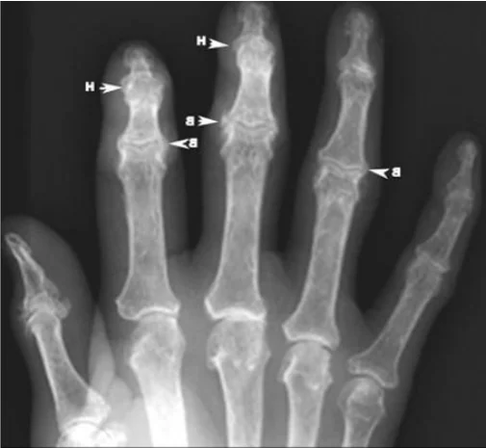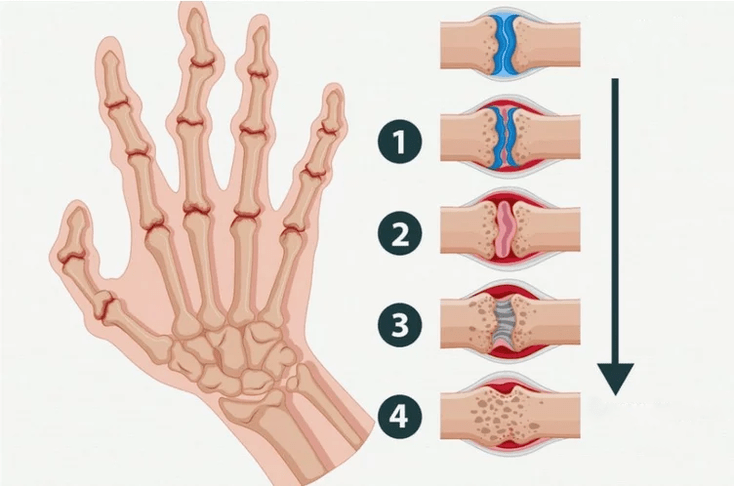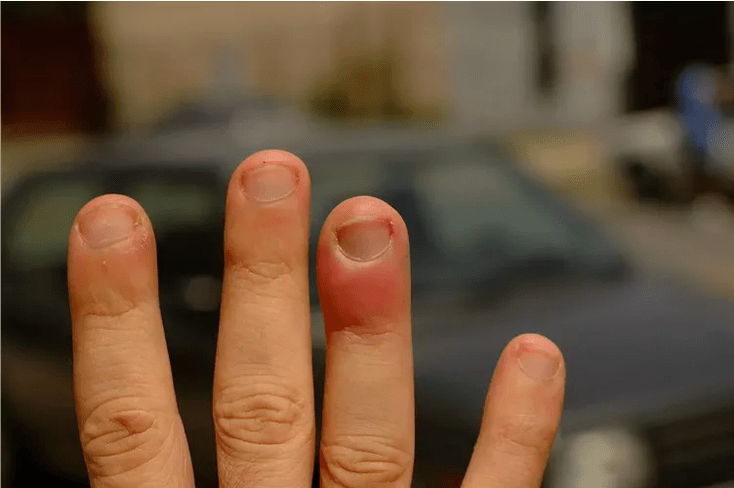
Pain in the joints of the hand can arise from muscle fatigue or be a sign of a dangerous systemic disease. Fortunately, the latter occurs much less frequently. Most often, doctors are faced with ligamentous injuries and problems that respond well to local treatment. If the joints of the hand hurt, the causes and treatment are very diverse. To treat hand pathologies, it is important that the patient seeks help in a timely manner, especially if the fingers are deformed: the longer they are in a forced position, the more difficult it is to restore their function. In the article we will talk about possible diagnoses in which the joints of the hands hurt, what to do and how to treat such diseases.
Pain in the little finger joints: causes
Patients who experience numbness, clicking, or pain in the finger joints when bending, stretching, or at rest may have different diagnoses.
"Snapping finger, " also known as stenosing ligamentitis or Knott's disease
One of the most common causes of hand pain. This is a benign pathology in which it is very difficult to independently straighten the finger from a bent position. The disease is common in both women and men and is associated with damage to the annular ligament of the hand. There is a feeling as if the finger is "stuck" in one position. Usually the joint of the middle finger of the right hand as well as the ring or thumb hurts. In left-handed people, the left hand is more often affected.
Risk factors include:
- Wrist flexor muscle fatigue. This can happen when working at a computer for long periods of time, traveling long distances, carrying heavy bags, playing the guitar, sustaining repeated blunt injuries to the hand, or working with tools that require a firm grip, such as construction.
- Metabolic disorders in the body: diabetes mellitus, reduced thyroid function – hypothyroidism.
- Smoking – Nicotine damages small blood vessels and nerves.
- Previous injury to the palm or base of the fingers.
Hand injury
These include fractures, bone cracks, joint dislocations, fractures and sprains of ligaments and muscles. A condition called hammertoe is common. This finger is bent and hurts a lot when you try to straighten it. It differs from the "snap finger" in the following features:
- Reason for appearing. "Hammerfinger" is a result of an injury, for example from a strong blow to the tip of an outstretched finger, for example from being hit by a ball while playing basketball.
- Localization of flexion. The mallet finger is bent at the distal interphalangeal joint, the small joint of the finger closest to the nail. The "snap finger" is bent at the proximal interphalangeal joint, the second finger joint from the nail, or the metacarpophalangeal joint, which connects the finger and the palm itself.
- The mallet finger is often swollen, blue and deformed, especially if there is a fracture of the phalanx.
arthrosis
This is a degenerative-dystrophic disease of the joints, a common pathology in patients over 40 years old, especially in women. The cartilage tissue that forms the joint is destroyed and the amount of fluid in the joint decreases. As a result, the joint becomes "dry" and its mobility decreases. In later stages, the bones that form the joint are also destroyed and "growths" - osteophytes - can appear on them. The interphalangeal joints of the fingers are usually affected. The patient finds it difficult to clench his hand into a fist or hold heavy objects, which significantly affects everyday life.

Rheumatoid and psoriatic arthritis
These are autoimmune diseases. The basal and metacarpophalangeal joints are most commonly affected. Since these diseases are systemic diseases that lead to changes throughout the body, there is usually pain and swelling in the joints of both hands. In addition, such patients often have other symptoms: weakness, fever, loss of appetite. Severe rheumatoid arthritis can have extra-articular manifestations and affect the heart, lungs, eyes, blood vessels and other organs. Despite its name, psoriatic arthritis can occur even when there are no symptoms of the skin disease psoriasis.

Gout and pseudogout
Metabolic disorders in which hard crystals are deposited in the joints. In gout, uric acid, a product of purine metabolism, is deposited in the form of crystals. Purines are formed in the body and also come from food. Gout crystals can appear not only in joints, but also under the skin and in tendons. The body reacts to this with severe inflammation. Pseudogout is similar in symptoms to gout, but is caused by the deposition of another substance - calcium pyrophosphate. Both diseases are treated with medication, although the medications are slightly different.

Tumors and cysts
This is a very rare pathology; the vast majority of hand tumors are benign. Cysts can occur in bone tissue and joints. They cause pain and, when large, affect joint mobility.
Infectious diseases of the fingers
Most common: felon and its variant – paronychia. This is an infection of the periungual tissue. Other infections include:
- Cellulite - inflammation of the subcutaneous tissue,
- Lymphangitis - inflammation of the lymphatic vessel,
- Abscesses – collections of pus,
- Osteomyelitis – inflammation of the bone.
Patients with hand infections usually report previous minor trauma. The risk of these diseases increases when the immune system is weakened.

Carpal tunnel syndrome
Caused by compression of the median nerve in the carpal tunnel, which consists of wrist bones, ligaments and tendons. Women suffer from this syndrome more often than men. Conditions that increase the likelihood of developing the disease: thyroid disease, pregnancy, obesity, diabetes. Constant work with the wrist held in a stretched position for long periods often becomes a provoking factor. This is especially true for people whose jobs involve assembling small parts, such as tailors or surgeons, or who work on computers. Symptoms occur in the fingers supplied by the median nerve: the thumb, index finger, middle finger and half of the ring finger near them. It usually involves not only pain, but also numbness, tingling and tingling, and sometimes weakness in the hand.
Dupuytren contracture or palmar fibromatosis
With this disease, it is impossible to fully straighten the fingers, they are in a forced semi-flexed position, which impairs the function of the hand. Dense connective tissue strands initially form in the palm tendons and are then shortened. The disease occurs more often in men over 50 years of age and has a clear hereditary predisposition. As with many other hand diseases, the risk increases due to diabetes, smoking and occupational hazards.

The list of possible diagnoses for pain in the wrists also includes a number of rarer diseases: vibration disease, vasculitis, etc. Due to this variety, it is better not to delay contacting a specialist.
Symptoms
Symptoms depend on the disease and the causes that caused it. The main symptom of problems with the joints of the hand and its other structures is pain, but it is important to evaluate all its features:
- The onset of pain, which may be acute or gradual.Diseases caused by degenerative changes and excessive fatigue of the ligament system are characterized by a gradual onset, as these processes take time to develop. Autoimmune diseases can manifest either gradually or acutely. Exacerbations of gout and pseudogout occur suddenly and reach peak symptoms within a few hours. Trauma is also associated with sharp, stabbing pain.
- Time and factors for the onset or worsening of pain throughout the day.Carpal tunnel syndrome can cause hand pain at night; With osteoarthritis, the pain increases when the joints are put under strain; In rheumatoid arthritis, pain is most severe in the first 30 minutes after waking or after prolonged inactivity.
In addition to pain, patients may notice other associated symptoms including:
- Features of flexion and extension of joints: With a "snap finger" the joint is locked in flexion, but can be carefully transferred to an extended position, while "hammer finger" and contracture cannot be fully extended. With rheumatoid arthritis, you can observe thickening of the fingers in the joints and their deformation. With pathology of the ligaments, nodules can be felt in their composition.
- Stiffness and limitation of movement in the joints.
- With gout and autoimmune arthritis, the patient notices redness and swelling, the joint feels hot - these are symptoms of inflammation.
- When the nerves are damaged, you may experience numbness, goosebumps, tingling, and decreased sensitivity to heat, cold, and touch.
- With vasculitis - an inflammation of the blood vessels - the fingers often turn white or blue.
- Weakness of the hand can be observed in many diseases: this indicates damage to the nerves and also occurs with injuries.
- General symptoms such as weakness, fever and problems in other organs, the cause of which you do not know, indicate a systemic nature of the disease. In these cases, it is better to see a doctor immediately.
diagnosis
The diagnosis begins with a consultation with a specialist, who asks in detail about symptoms and the presence of accompanying and hereditary diseases. The doctor then has to examine the patient and palpate the hand. In some cases, these manipulations are enough to make a diagnosis. However, to confirm and clarify this, additional studies are prescribed. It may be:
- X-ray of hands in different projections- the most commonly used and accessible method for assessing the condition of bones and joints. This is necessary if there is a suspicion of a fracture, foreign body, developmental disorder, tumor or cyst, as well as rheumatoid arthritis and arthrosis. Osteoarthritis on the X-ray is manifested by a reduction in the size of the joint cavity, as well as the presence of bone growths - osteophytes.
- CT scan(CT). Used to better visualize complex fractures and assess the condition of the joints.
- Ultrasound of the soft tissues and joints of the hand. Allows visualization of ligaments, tendons, nerve trunks and the condition of joints.
- MRI. The method provides clear layer-by-layer images of all hand structures. The main indications for use are injuries to ligaments and tendons.
- Electroneuromyography. This method is necessary to assess the conduction of nerve impulses. It is used when carpal tunnel syndrome is suspected.
- Blood tests.Most commonly this is:
- Metabolic indicators - for example, glycated hemoglobin and blood sugar in diabetes, since metabolic diseases affect the condition of nerves, small vessels and ligaments.
- Tests for the diagnosis of autoimmune diseases: erythrocyte sedimentation rate, C-reactive protein, rheumatoid factor, antibodies to cyclic citrullinated peptide.
Which doctor should I contact?
Due to their enormous diversity, diseases of the hand structures often require consultation with specialists with different profiles. If there is no actual injury, a therapist should be consulted first; if there is an injury, a traumatologist should be consulted.
Autoimmune diseases are treated by rheumatologists. Diagnosis and treatment of hand injuries and tumors is carried out by orthopedic traumatologists and surgeons. In case of metabolic disorders, consultation with an endocrinologist is necessary. If weakness and numbness in the hand are detected, you should consult a neurologist.
How to relieve pain in your finger joints
Treatment can be surgical or conservative.
- Surgical treatmentnecessary for purulent processes on the hand, as well as for complex injuries. Open wounds also require surgical treatment. Any wound is a source of infection, and these patients are prescribed antibiotics and debridement. Closed fractures can be treated conservatively. They begin with rigid fixation of the fracture site: for 7-10 days for non-displaced fractures and for 3 weeks for displaced fractures. The patient then wears a special orthosis on the hand until the bone is completely restored - usually 4-10 weeks, sometimes longer.
Conservative treatmentIn autoimmune diseases of the wrists, it is special - it is based on drugs that suppress the immune response and is prescribed by a rheumatologist. For problems with the musculoskeletal system, systemic drug treatment is used as part of complex therapy. For pain in the joints of the hand, nonsteroidal anti-inflammatory drugs may be indicated to reduce pain and inflammation. Local influence methods achieve a good effect:
- InjectionsCorticosteroids into the joints of the hand, into the tendons. They effectively relieve inflammation, but have side effects and therefore must be used according to strict indications.
- Gentle fixation of the handwith orthoses or an elastic bandage. The fixation position depends on the diagnosis.
- Exerciseson the hand muscles, which a specialist will help you choose depending on the pathology.
- Acupuncture.This method involves inserting sterile needles into biologically active points, which relieves pain and improves joint mobility.
- Shock wave therapy.In recent years it has become increasingly popular in treating ligament problems. Effective and safe for the treatment of "snap finger", deforming osteoarthritis, reduces the likelihood of relapse, improves joint mobility and overall hand functionality.
- Kinesio taping.Special tapes are stuck to the hand to help stabilize the joint in a comfortable position. This means he recovers faster.
- Laser therapy.Reduces pain and helps restore cartilage, which is extremely important in osteoarthritis.
- Magnetic field therapy.The aim is to relieve pain, inflammation and swelling.
Follow
Most patients with hand injuries and degenerative processes, trigger finger and carpal tunnel syndrome can restore joint function and return to their normal lifestyle. The leading role in the prognosis of the disease is played by early consultation with a doctor, the correct wearing of a bandage, if necessary an orthosis, and compliance with given recommendations. If the joints of the hand are left untreated for a long time, deformations are possible that cannot be completely eliminated. If you have any complaints about the condition of your hand, immediately contact a specialist who will select the therapy necessary for you.
prevention
- Treat common risk factors.The risk of musculoskeletal problems in the hand increases with metabolic disorders, smoking and hormonal disorders. It is important to maintain normal blood sugar levels, especially if you have already been diagnosed with diabetes. Patients with gout are recommended a special diet, and some are prescribed anti-gout medications. It makes sense to check the condition of the thyroid regularly. A deterioration in its function negatively affects the immune system and the entire body.
- Pay attention to your hand if the risk of joint diseases is increased.For example, if you strain your hands at work, make sure you are in the most comfortable position possible, do not leave your hands constantly bent, give them a break and warm up a little. Play sports with special gloves and monitor the condition of your skin and nails so that infection does not penetrate the tissues of your hand. Have regular medical check-ups.
Follow the listed recommendations to reduce the risk of problems with your hands.




















